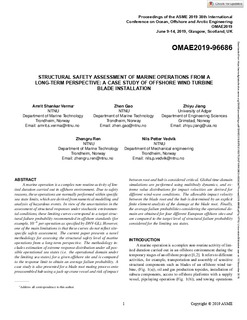| dc.contributor.author | Verma, Amrit Shankar | |
| dc.contributor.author | Gao, Zhen | |
| dc.contributor.author | Jiang, Zhiyu | |
| dc.contributor.author | Ren, Zhengru | |
| dc.contributor.author | Vedvik, Nils Petter | |
| dc.date.accessioned | 2019-11-21T12:18:38Z | |
| dc.date.available | 2019-11-21T12:18:38Z | |
| dc.date.created | 2019-11-19T16:27:34Z | |
| dc.date.issued | 2019 | |
| dc.identifier.isbn | 978-0-7918-5878-3 | |
| dc.identifier.uri | http://hdl.handle.net/11250/2629792 | |
| dc.description.abstract | A marine operation is a complex non-routine activity of limited duration carried out in offshore environment. Due to safety reasons, these operations are normally performed within specific sea state limits, which are derived from numerical modelling and analysis of hazardous events. In view of the uncertainties in the assessment of structural responses under stochastic environmental conditions, these limiting curves correspond to a target structural failure probability recommended in offshore standards (for example, 10−4 per operation as specified by DNV-GL). However, one of the main limitations is that these curves do not reflect site-specific safety assessment. The current paper presents a novel methodology for assessing the structural safety level of marine operations from a long-term perspective. The methodology includes estimation of extreme response distribution under all possible operational sea states (i.e. the operational domain under the limiting sea states) for a given offshore site and is compared to the response limit to obtain an average failure probability. A case study is also presented for a blade root mating process onto preassembled hub using a jack-up crane vessel and risk of impact between root and hub is considered critical. Global time-domain simulations are performed using multibody dynamics, and extreme value distributions for impact velocities are derived for different wind-wave conditions. The allowable impact velocity between the blade root and the hub is determined by an explicit finite element analysis of the damage at the blade root. Finally, the average failure probabilities considering the operational domain are obtained for four different European offshore sites and are compared to the target level of structural failure probability considered for the limiting sea states. | nb_NO |
| dc.language.iso | eng | nb_NO |
| dc.publisher | ASME | nb_NO |
| dc.relation.ispartof | ASME 2019 38th International Conference on Ocean, Offshore and Arctic Engineering. Volume 3: Structures, Safety, and Reliability | |
| dc.relation.uri | https://asmedigitalcollection.asme.org/OMAE/proceedings/OMAE2019/58783/V003T02A074/1067670 | |
| dc.title | Structural Safety Assessment of Marine Operations From a Long-Term Perspective: A Case Study of Offshore Wind Turbine Blade Installation | nb_NO |
| dc.type | Chapter | nb_NO |
| dc.description.version | publishedVersion | nb_NO |
| dc.identifier.doi | 10.1115/OMAE2019-96686 | |
| dc.identifier.cristin | 1749585 | |
| dc.relation.project | Norges forskningsråd: 237929 | nb_NO |
| dc.description.localcode | Copyright © 2019 ASME | nb_NO |
| cristin.unitcode | 194,64,20,0 | |
| cristin.unitcode | 194,64,92,0 | |
| cristin.unitname | Institutt for marin teknikk | |
| cristin.unitname | Institutt for maskinteknikk og produksjon | |
| cristin.ispublished | true | |
| cristin.fulltext | original | |
| cristin.qualitycode | 1 | |
